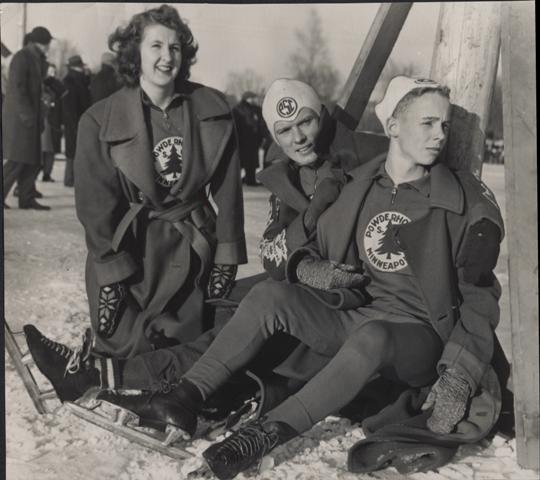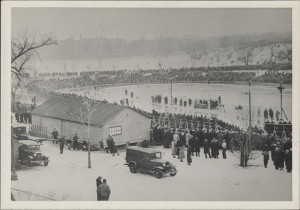Today Minnesota sends Nordic skiers and hockey players to the winter Olympics. Sixty years ago, Minneapolis produced many of the world’s top competitors in speedskating. “Skating was the natural thing for a boy to do then,” explained Ken Bartholomew, who won 14 national championships and an Olympic silver medal for speedskating in 1948. “You either skated or did nothing in those days. You could sled or skate, but after that things were pretty dull in the winter.”
Speedskating got its start among Scandinavian immigrants to the city, who started the Norwegian-American Skating club in 1919. The next year this became the Minneapolis Skating Club, which trained and competed at Lake of the Isles, where the Park Board maintained a quarter mile track during the 1920s.
In 1930, a new track was constructed at one of the most popular parks in Minneapolis. Powderhorn Park quickly became the epicenter of the city’s speedskating culture. The club–with the support of the Minneapolis Park Board and a handful of American Legion posts–trained a generation of athletes who dominated international speedskating competitions for three decades.
Speedskating was inexpensive for athletes, a significant advantage during the Great Depression. And it was exciting to watch. Athletes started in a pack, racing one another instead of the clock. Competitors bumped and knocked each other on the way to the finish line, ending their races bruised and battered. Crashes and take-downs were inevitable on the small track at Powderhorn, where every race required athletes to circumnavigate the oval multiple times.
Powderhorn was renowned across North America for its race course, which hosted national and international speedskating competitions. Athletes called it “the best ice in the United States” and remember it as harder and faster than the artificial surfaces that became common in the 1960s.
For local kids, Powderhorn sponsored the “silver skates” competition, which pitted beginners against one another in a season-long race. At the end of February, the cumulative winner was awarded a pair of skates. It was like the story of Hans Brinker, with a lake instead of canals. Bartholomew won his first Silver Skate race at Powderhorn in 1932.
In 1934, 50,000 people flocked to Powderhorn Park to watch the U.S. Outdoor Speedskating Championships, according to park historian David C. Smith. In January 1935, it was the site of tryouts for the 1936 Olympic skating team. When Olympic tryouts were held at the park again in 1947, four members of the Powderhorn Skating Club made the nine man American team. Ken Bartholomew won a silver medal in St. Moritz. Johnny Werket placed sixth. Two other Minneapolitans– Arthur Seaman and Robert Fitzgerald–also competed for the United States.
Photos and information for this post is taken from the vertical files of the Minneapolis Collection at the Hennepin County Central Library.
The photo at the top shows members of the Powderhorn Skating Club in January 1947. From left to right we have Gerry Scott (senior woman champion), Ken Bartholomew (Olympic champion) and Bob Dokken, who the newspaper identified as a juvenile champion. The photo in the text shows the Powderhorn race track in 1934, when it was the site of the U.S. Speedskating Championships.

